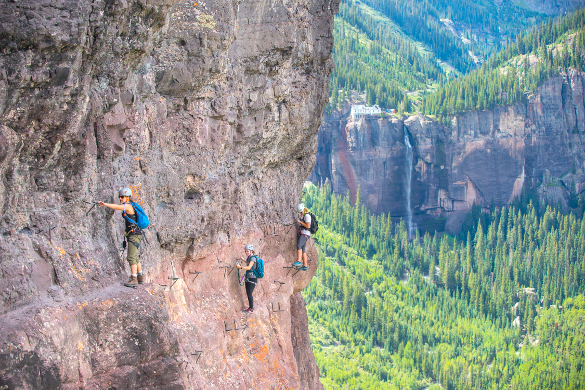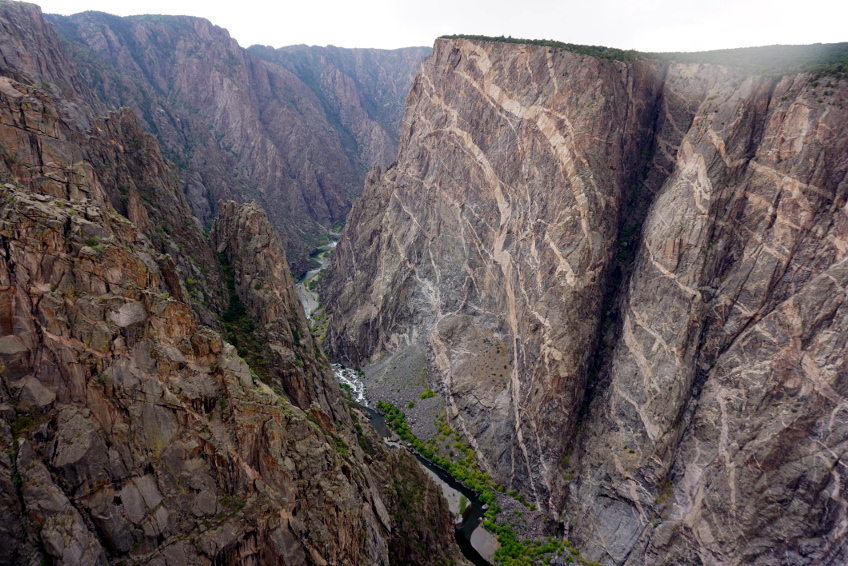A visit to Colorado would not be complete without exploring its captivating mountains, rivers, deserts and green valleys, all of which are home to some of the most beautiful wildlife. This summer, I spent three weeks in the small town of Telluride, attending the workshop on neuromorphic hardware. After the workshop, Colleen, an amazing friend of mine and a partner in crime in this adventure, drove all the way down from Boulder to meet me in Telluride, which is where our journey started.

Us traversing Via Ferrata in Telluride, Colorado (Credit: Life Feeling Photography)
We could not leave Telluride without doing the local Via Ferrata (Italian for Iron Path), a horizontal traverse over a rocky mountain face that surrounds the town. To (safely) traverse these rocks, one needs a climbing harness, a helmet and a special kit with carabiners that attach to cables fixed on the rock. Rock features and fixed iron rungs are used to move forward, while (most of the time) a person is attached to the fixed cable that limits falls. Climbing skills can be helpful as they provide some confidence at such heights, but those not used to hanging a few hundred meters above the ground (which, well, should really be the most of us), some parts (especially those unprotected) can feel somewhat nerve-wracking. But, the views and the experience are absolutely worth those few extra heartbeats per minute.
After Telluride, we set out to drive to Mesa Verde, a national park located in the southwest of Colorado. However, as the sun was setting, the San Juan mountain range turned out to be just too attractive, so we decided to pitch our tent for a night and continue our journey in the morning. Mesa Verde is located in a very arid area that lies on the intersection of low desert plateaus and mountains. It is a region that was once home to an ancient Native American population and has been designated a UNESCO world heritage site. To protect and preserve the dwelling sites, the only way to explore them was with a guided tour, which I enjoyed quite a lot.
The next step on our journey was the city of Durango. This was not the most exciting part of our trip, as we got caught up in a heavy storm while climbing. We had to succumb to the forces of nature and leave our gear on the wall, and then pound through mud and dirt to reach the car (which, luckily, was not far away from the climbing area). Next day, we came back after everything dried up to take the quickdraws we left. Needless to say, this was not the proudest moment of my life, but I learned a lesson – to double check the weather, and not to rely on “it was hot and sunny past two weeks, therefore it will be sunny and hot today”. That is not how probability works.
After Durango we drove to the town of Ouray, with a lunch stop in Silverton, which made me feel as if we travelled back in time of cowboys and bandits of the American Old West. In Ouray, we had a good day of climbing, followed by relaxing in hot springs conveniently located right in the centre of town.
After getting the flavour of the Wild West, we visited the Black Canyon of the Gunnison national park.
Although it appears to me that it is one of the less known parks (at least
among non-US visitors), its grandeur is comparable to that of its better known
siblings in the south.

Black Canyon of the Gunnison National Park (and a few rain drops on camera lens), Colorado
The steep cliffs of the canyon boast themselves with marvellous patterns of different colorful rock veins that pierce the walls. We descended down the steep route to the Gunnison river that formed the canyon, and took a break in the shade of tall pine trees while listening to the river. Going back was not easy, but it was a good training for the things we had in mind for the rest of our trip.
Our next stop was Lake City, another small town where we spent a day to prepare ourselves for summitting the Wetterhorn peak. The peak is over 14,000 feet (4267 m) in height, which is the highest altitude I’ve ever been at. In the US (or, according to Wikipedia, mountaineering parlance of the Western US), people refer to such mountains as fourteeners, and some appear to take pleasure in “collecting” them as as other do in catching all the Pokemons.
At that altitude, the effective oxygen level is about 60% of that at the sea level, which makes any kind of activity more difficult. Every movement takes more effort, the air is very dry and being closer to the sun means a higher chance of sunburn. The mountains create their own microclimate so the weather can be quite unpredictable as well, carrying an increased risk of being struck by lightning if stuck above the tree line. Not to mention, good planning, preparation and navigation skills are quite important to stay on the trail and know what (not) to do when getting lost. After spending a few weeks at high altitudes, I felt prepared to approach this challenge, equipped with extra red blood cells and a few new skills.
We pitched our tent at the base of the trailhead that leads to Wetterhorn. Next day in the morning, we started our hike well before the sunrise. The climb was 7 miles long (about 11 km) but included close to 3300 feet (1 km) of elevation gain and some scrambling towards the end. It started fairly easy, and we were above the tree line just as the sun started to rise. It was amazing to see the peaks of surrounding mountings covered in early morning orange light. We reached the summit around 10 am, where we were rewarded with a breathtaking panoramic view of the neighbouring mountains. It is difficult to express the feeling of awe one experiences when standing there on the top. Even the photos can’t truthfully depict the immense scale of those beautiful landscapes and formations that were shaped by forces of nature for millions of years. Standing on top of that mountain was certainly one of the highlights of this trip. On our way back to Boulder we stopped by a few more places: Canyon City, Florissant Fossil Beds National Monument and The Garden of The Gods.

At the Wetterhorn summit, Colorado